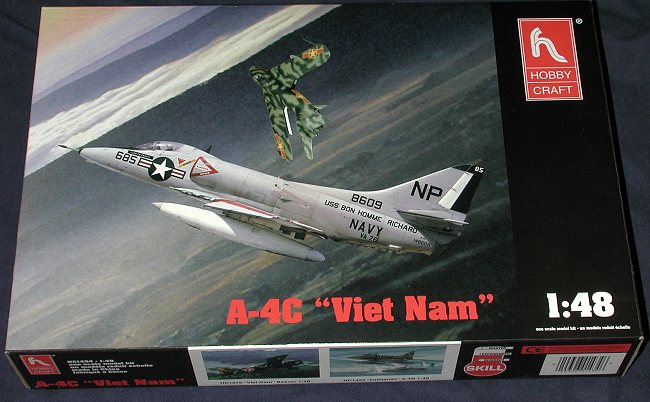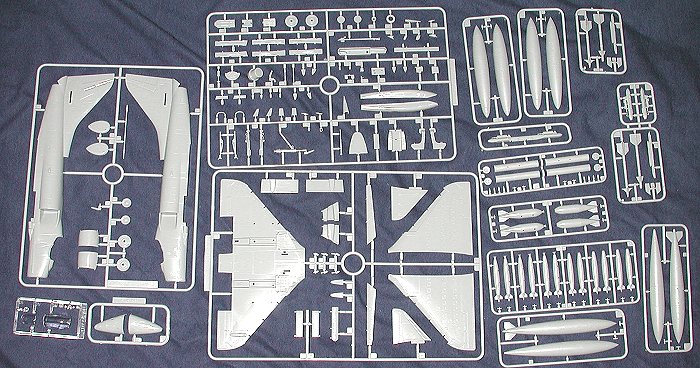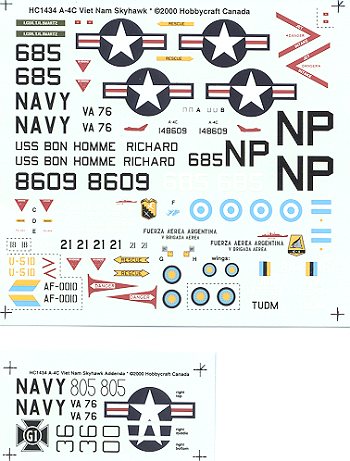
| KIT: | Hobbycraft 1/48 A-4C Skyhawk |
| KIT # | HC1434 |
| PRICE: | $17.98 |
| DECALS: | Four aircraft |
| REVIEW & | |
| NOTES: |
|

| HISTORY |
When Douglas developed the Skyhawk, little did they realize thatthey were starting a legend. The Skyhawk is one of the more recognized aircraftamong enthusiasts and those who just dabble in aircraft. With an operationallife span that started back in late 1955 after it completed carrier quals andwas OK'd for issue to fleet squadrons, the 'Scooter' is still flying as frontline equipment with a number of air forces around the world. No matter how youlook at it, 45 years of service is a long time!
Originally developed as a replacement for the F9F Panther, thenbearing the brunt of light attack roles in Korea, the A4D was basically thesmallest package that could do the job required. The airframe is so robust that,like the DC-3, there really is no limit on airframe time. Would a service decideto continue upgrading the aircraft, it could do so as long as spare parts areavailable. This is basically what New Zealand is doing with their Skyhawks.
This particular version is the A-4C (previously known as theA4D-2N). It differs from the earlier versions in that it was able to operate atnight (hence the 'N' suffix). First flying in 1959, this version has terrainclearance radar in a slightly longer nose from its predecessor. It also has anauto pilot, angle of attack indicator system, LABS bombing (Low Altitude), and abetter ejection seat. It is the longer nose that is the visual clue whencomparing it with the earlier A-4B. Later E models had an even longer nose. Itwas later fitted with a more powerful engine from its earlier cousin. Whenreplaced in fleet squadrons by later version Skyhawks or other types, it wasrefurbished with upgraded avionics and then issued to the reserves as the A-4L.These had the upper fuselage dorsal 'hump' added to them as the visualclue.
The A-4C bore the early brunt of light attack duties in Vietnamuntil supplanted by the later A-4E/F versions. It was even credited with a Migkill when a Mig-17 blundered into the path of a Scooter who fired off it's Zuniunguided rockets at it and knocked it down. Some A-4Cs were sold to foreigncountries seeking an inexpensive and relatively easy to maintain attackaircraft. There are even a few warbird Skyhawks flying around.
| THE KIT |

Considering howpopular the A-4 is, it is surprising that there have been few kits of it in 1/48scale. I can only think of three injected styrene kits produced up to thebeginning of 2001, all of them A-4Es or later. There is the Fujimi kit (which isbasically 1/50 and better left alone, the still very nice Monogram A-4E kit andthe ESCI Skyhawks. Early this year Hasegawa presented us with a very niceA-4E/F, and now Hobbycraft joins the ranks.
The HobbycraftSkyhawks had been promised for quite some time, but market forces and moldingproblems being what they are, the kit was delayed until now. Had Hobbycraftreleased this kit 6 months ago, it would have been quite a heavy seller, butHasegawa has stolen some of their thunder. Hobbycraft has decided to to a bit ofa blitzkrieg on Hasegawa by not only releasing four kits, but beating Hasegawato the punch and putting out an early A-4B and A-4C, the first ones in thisscale. Released at the same time were two A-4E/F kits, one as an aggressor, andthe other as an Israeli version, including the tailpipe extension. Obviously,Hobbycraft is going for the Scooter market big time.
Thisparticular kit is the A-4C boxing. Hobbycraft has made the kits with a largenumber of interchangeable bits and pieces to get maximum use out of the molds.It is apparent that we will eventually be able to do every variant of theSkyhawk that has been built. At least, single-seaters anyway. As you can see,you get a LOT of parts. You also get a full weapons load, something that is notoffered by the Hasegawa kit. It is really not fair to compare the two kits asthey are not in the same price bracket, the Hobbycraft kit being about $10 lessexpensive. However the comparison is inevitable. One just needs to keep in mindthat there is the large price difference.
Now, what are thedifferences in the kits? I have mentioned the weapons. The Hobbycraft kit isalso not a well detailed as the Hase kit. That isn't to say it is bad, just notas well detailed. The panel lines are a bit bigger and there isn't the petitedetail of the Japanese kit. Where the Hasegawa kit has intake trunking and anengine compressor as well as a long tailpipe, the Hobbycraft kit doesn't. TheHobbycraft cockpit is less detailed as well, though it does have raisedinstrument panel and side console detail, just not as much of it. Rather than afull fuselage half, the Hobbycraft kit has a separate nose, obviously to be ableto handle the different versions with the same basic fuselage. In Hobbycraft'sfavor, other than the weapons, is the separate nose wheel. Hasegawa has itmolded in with the strut. Both have separate slats and flaps, though Hasegawa'slook a bit easier to install. Probably the most glaring difference that Inoticed when looking over the parts is the clear bits. They not only seem tohave 'soft' detailing, but the windscreen seems too wide. It also seems that youcannot pose the canopy open. The speedbrakes are also molded closed, but thisreally isn't that big a deal as most Scooters had them closed on the deck.
Now the box. It is nice and sturdy, which is good. It alsoopens from the ends, which isn't. It seems as if the industry is going away fromstandard top and bottom boxes, and frankly it isn't a trend that I like. Theonly thing to do about it is to keep your Tamiya and Hasegawa boxes so that youcan build your Hobbycraft and Revell kits! Finally, I like the way thatHobbycraft bagged this kit. There were no more than two large sprues per bag andthe decals were bagged separately. This really cuts down on parts gettingscratched or broken off during shipment. With all the extra bits that you willhave left over, your spares boxes should soon be bulging. Nowthat I have gone into a rather more detailed preview than I usually do, what doI think of the kit? Well, despite it not being up to the standard of theHasegawa kit, it is darn close. It offers several features that the Hasegawa onedoesn't. like the separate nose wheel and full weapons load. The weapons setneeded to complete the Hasegawa kit will easily add another $10-15 to the priceof the kit. This kit also does the earlier versions that Hasegawa won't get tofor several months. Despite my nitpicking, when you look atthe overall quality of the kit and the value you get for the money, you can'thelp but be pleased with it. I hope that Hobbycraft sells a lot of these, itreally deserves to do so. I know that I plan to build several! REFERENCES McDonnell Douglas Aircraft Since 1920, Vol I, by Rene JFrancillon, 1989, Naval Institute Press Review kit courtesy of me and my wallet! If you would like your product reviewed fairly and fairly quickly by asite that has over 1,800 visits a day, please contactme or see other details in the  On to the decals. They are beautifully printed and razorsharp. Hobbycraft has really improved their kit decals and they are a pleasureto use. These seem no different. There is even an addendum to take care of adecal glitch. Nice touch. You get four aircraft. One USN, two Argentine and oneMalaysian bird. Having the painting info on the back of the box is a great idea.Two little things. One is that it would have been nice to have an upper fuselagedrawing of the Malaysian bird instead of just wings and stabs. Second is thatthe markings on the Argentine and Malaysian bird are almost invisible whenprinted over the dark brown or greens. I had originally thought that themarkings for Swartz's Mig killing plane were incorrect. It appears that this isthe scheme used during the BHR cruise when the kill occured. Most othersources show the later Independence cruise markings which are muchdifferent. There is also some thought that the color of the markings isn't blackbut a dark green. More research into this is really needed.
On to the decals. They are beautifully printed and razorsharp. Hobbycraft has really improved their kit decals and they are a pleasureto use. These seem no different. There is even an addendum to take care of adecal glitch. Nice touch. You get four aircraft. One USN, two Argentine and oneMalaysian bird. Having the painting info on the back of the box is a great idea.Two little things. One is that it would have been nice to have an upper fuselagedrawing of the Malaysian bird instead of just wings and stabs. Second is thatthe markings on the Argentine and Malaysian bird are almost invisible whenprinted over the dark brown or greens. I had originally thought that themarkings for Swartz's Mig killing plane were incorrect. It appears that this isthe scheme used during the BHR cruise when the kill occured. Most othersources show the later Independence cruise markings which are muchdifferent. There is also some thought that the color of the markings isn't blackbut a dark green. More research into this is really needed.